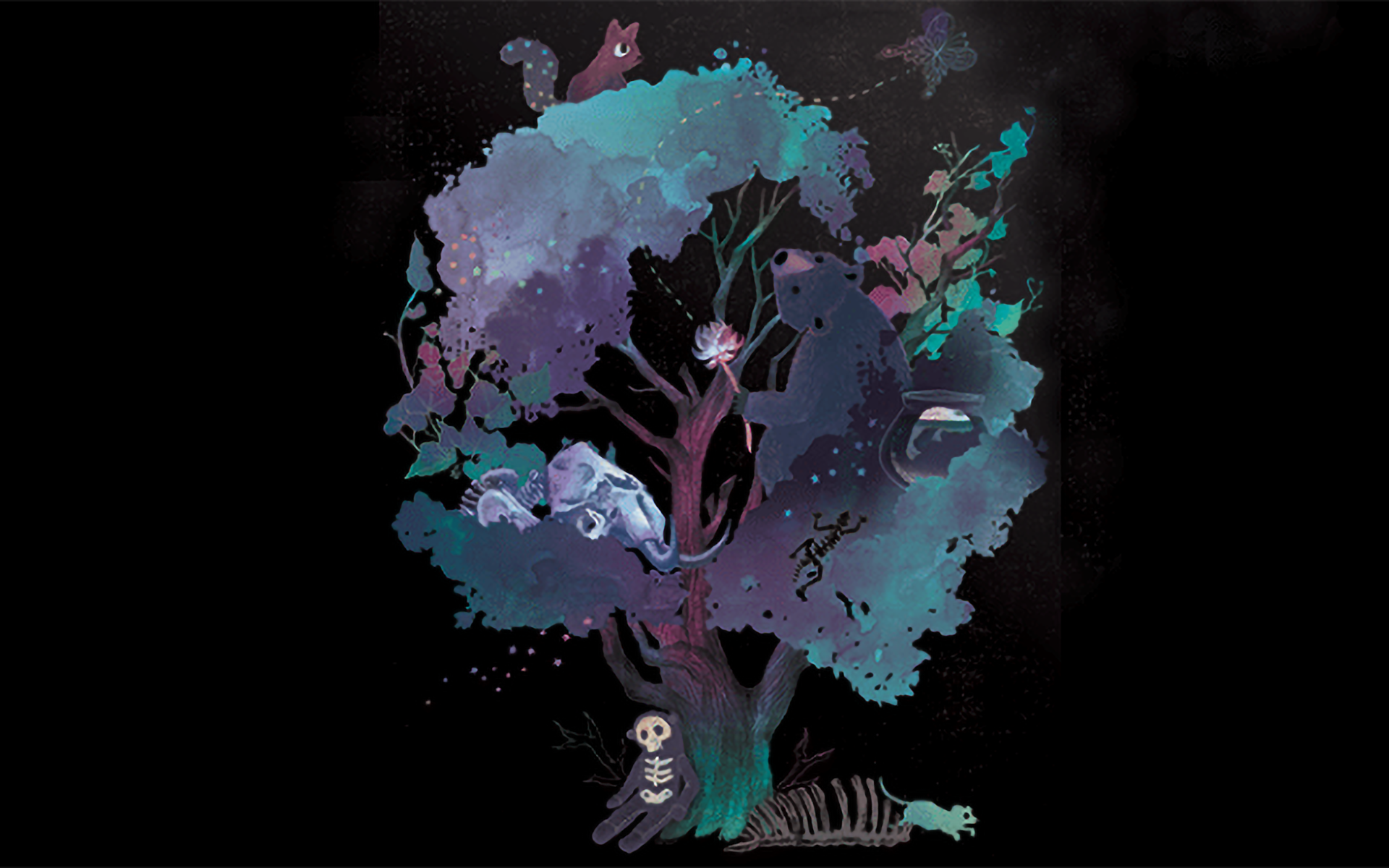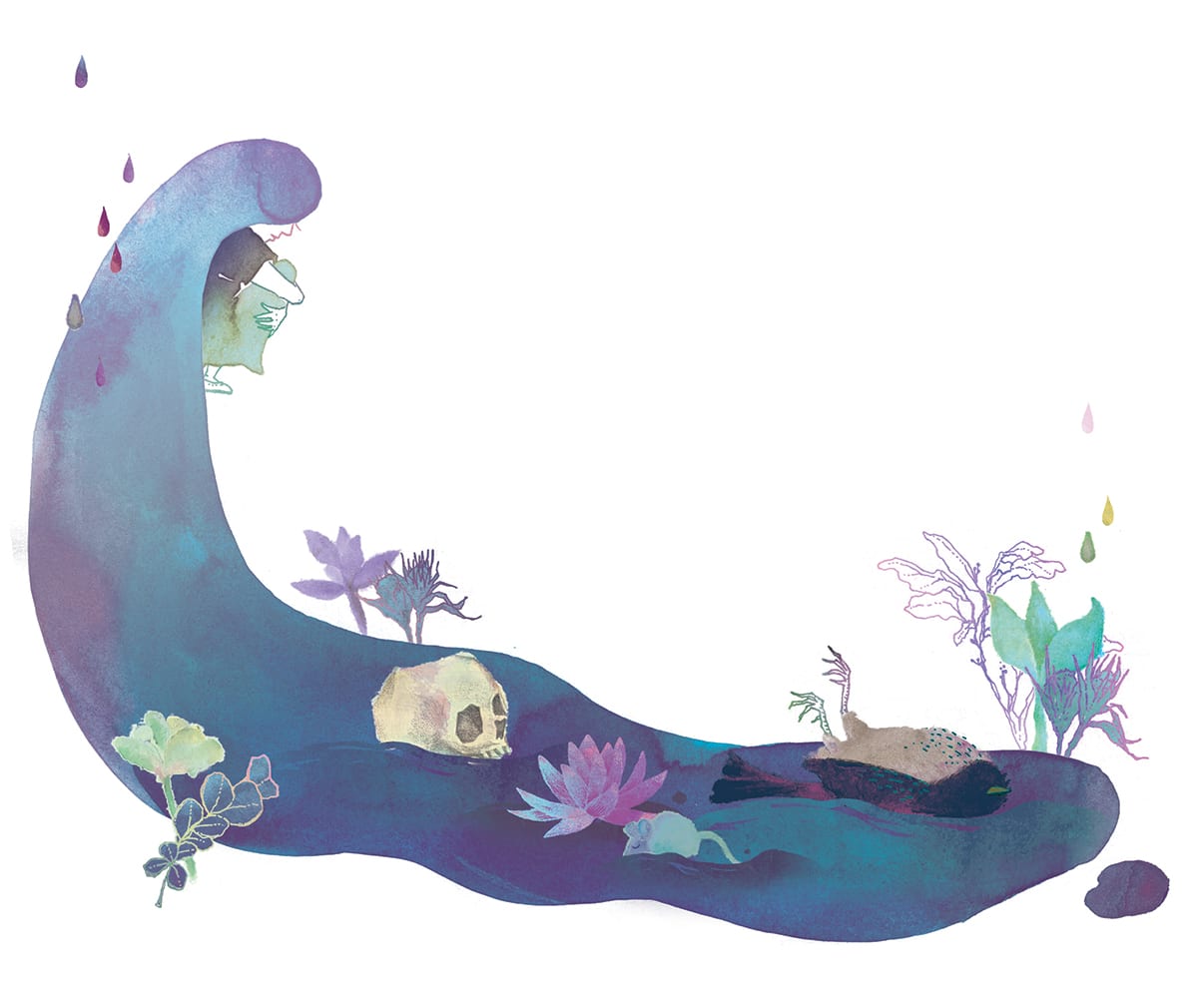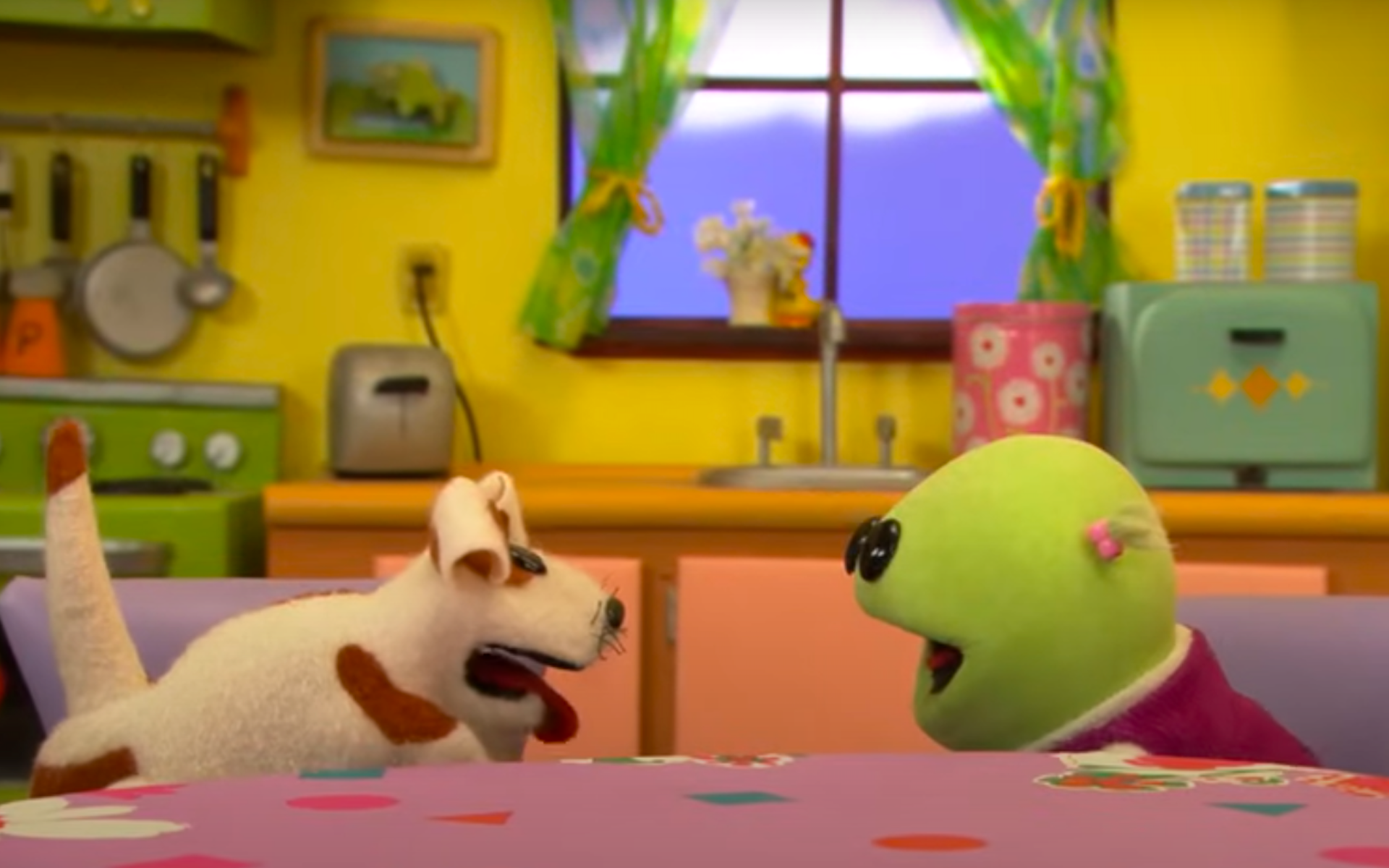Death is everywhere. The lifeless bugs on the windowsill. The dead mouse in the crawl space.
My preschooler, Opal, started plying me with questions when she was four. “Were you the one who died that mouse?” Or, “Do you think that moth knows he’s dead?” Cute out-of-the-mouths-of-babes comments tossed off as she buzzed on to her next activity. I’d gotten used to her frank, unemotional curiosity about death, but when her questions shifted from light banter to a source of terror, I was caught completely off-guard.
It happened just before her fifth birthday. She and her dad, Jesse, were settled on the couch with a copy of The Old Lady Who Swallowed a Fly, a book we’d read to her a dozen times. She swallowed the spider to catch the fly. / I don’t know why she swallowed the fly. / Perhaps she’ll die.Opal suddenly started to cry and said, “When I die, will I still be with you and Mommy?”
Jesse scooped our daughter into his arms and held her as she sobbed into his shoulder. “We love you. We’ll take care of you. We love you,” he assured her.
The next day was filled with more questions, increasing in urgency. Over breakfast, Opal asked, “Mommy, do you still eat when you die?”
I tried to keep my tone matter-of-fact, the way I always had. “No, honey, your body doesn’t need food anymore when you die.”
“It doesn’t? Can you see?”
“No, honey, you can’t see anymore, either.”
At this point in the past, she would have lost interest and moved on to hugging the dog or arranging her stuffed animals on her bed. But not now. “Then how will I know where to find you guys when I die?” The look in her eyes swung to terror and confusion. Then came a rushing stream of tears.
Oh dear, I thought to myself, what have I done? Not only that, I wondered how I, a seasoned mindfulness practitioner, could be so flummoxed by questions about death—the exploration of which is an important part of my practice?
It didn’t matter. I realized I was no more prepared to answer Opal’s questions than many parents of young children, meditators or not. Several other mothers I spoke to with kids around Opal’s age were as confused as I was. One mom told me that her son hasn’t asked about death yet, but she has no idea what she’ll say when he does. Another woman said her daughter is under the impression that “death is something that happens when you are very old, and we’ve just kind of let that assumption ride for now.”
When Opal started asking me about death, I didn’t want to lie to her or overlook the fresh wound of her concern. But I didn’t want to cause her nightmares either.
As it turns out, these moms and I are not alone in our confusion about how to talk to our children about death. Former hospice chaplain Joseph Primo, president of the National Alliance for Grieving Children and author of What Do We Tell the Children?, told me that the discomfort and befuddlement so many of us feel is common in our Western culture. “The fact that parents have to ask that question is really a symptom of a much bigger problem,” he explained. “It’s been multiple generations since we’ve been able to talk about death and dying in an open, healthy, constructive way.” This, he adds, despite the fact that death happens to every single living creature.
What’s more, Primo said, this state of affairs is really unfortunate for kids. “As a result, they wind up making sense of death and loss on their own, when the subject could be a way for adults to give them the tools and resources they need to explore their world, to imagine their life, and to begin wrestling with this part of the human condition.”
When Opal started asking me about death, I didn’t want to lie to her or overlook the fresh wound of her concern. But I didn’t want to cause her nightmares either. I navigated her questions with simple, generic responses and lengthy hugs until I was able to get a better grasp on how to respond.
I began by researching kids’ books on the subject, including Lifetimesby David Rice, and The Fall of Freddie the Leaf by Leo Buscaglia. Both stories focus on the cyclical nature of life. “We all fear what we don’t know,” The Fall of Freddie the Leaf tells us. “Yet, you were not afraid when spring became summer. They were natural changes. Why should you be afraid of the season of death?”
Not a bad start, still I needed more. I needed to know what information was appropriate for Opal’s age group so that I could answer her questions with confidence instead of panic.
Keep It Concrete
“School-aged kids don’t do well with symbolism and metaphors,” advised Joe Soma, a psychologist in Boulder, Colorado. “They need concrete details. It’s best to explain death in simple, scientific terms. Everything lives and dies. The trees and animals have to die to make room for new things to be born.”
“But what if saying that makes Opal even more afraid?” I asked.
“You can acknowledge her fear and tell her that adults feel scared, too,” he said. “But always bring it back around to something concrete like, ‘What did you do to take care of your body today?’”
Opal’s first reprieve from death-angst came during a trip to the farm with friends, days into her questioning. Animals and nature were just the ticket; she didn’t mention death for hours. Her daddy and I had talked to her about the cycles-of-life earlier that morning when we found her crying in the bathroom, toothbrush dangling from her lips. She seemed to take in our words, to understand death and rebirth in her five-year-old way. At the farm, I pointed out the baby pig and the fresh leaves on the trees. New life. But, on our way home, in the vulnerable place of post-play emptiness, she whispered, “Mommy, I’m thinking about it again.”
When we returned, Opal took stock of the life spans of everything in the house. “The fish will live the shortest. No, the plants will. Then the dog will die next, then the cat.” She paused to brush a clump of bangs from her eye. “You and daddy are next, right? But not for a long, long time, right, mama?”
Perhaps Opal was trying to escape thoughts of her own death by assembling lists of things she felt she understood. Mommy and Daddy are at the end of the list. The fish, the cat and the dog have to die before we even think of Mommy and Daddy dying. It’s almost as if those names and that list had the power to stave off death for Mommy, Daddy and Opal. Especially if repeated aloud.
Like Joe Soma, New York City psychologist— and my uncle—Richard Zuckerberg also stressed the importance of using concrete details when talking to kids about death. Moreover, he said, sometimes questions that seem to be about death are really about separation, about losing Mommy and Daddy. He thought this might be the case when I mentioned that Opal had been unusually volatile in the weeks leading up to her pressing questions.
He suggested I use concrete details to reassure her by saying, “I understand that you are worried, but remember how we came back after school today? We’ll always come back. We are taking good care of ourselves and plan to live a very long time, but if something ever happens to us, you will be totally cared for.”
I expected those words to breed more fear in Opal, but I was pleasantly surprised. Instead, she wanted to know who would take care of her. I recited a long list of friends and relatives who would be there for her, no matter what. I could see her taking in the names, one by one, as if she were using them to weave a huge safety net around herself.
Model Emotional Intelligence
In my quest for answers, I met with Michele Bourgeois, an educator, social worker, and school counselor in Lyons, Colorado, who teaches yoga, mindful breathing, singing, and art to elementary school children. She believes that, “If you give kids many avenues of expression on an average day, you are laying the groundwork for them to have ways in which to process grief when the need arises.”
Joseph Primo pointed out that, “If our end game is to prepare children for life and to give them the tools they need to be resourceful, empathic beings, then we are required to model warmth, encouragement, and a willingness to not know, yet to be present. We want our kids to know that they can tackle all things when they are surrounded by people who love them,” he said.
“Often, it’s not about us providing them with the answers, as much as creating the space for them to explore their own feelings.”
– Joseph Primo, president of the National Alliance for Grieving Children and author of What Do We Tell the Children?
When Death Is a Reality
So far my talks with Opal were about death in the abstract. But I couldn’t help wondering what to say when she experiences the death of someone close to her. Her 92-year-old Papa Jack and our grumpy but sweet old cat, Gilda, are beloved members of our family nearing the end of their lives.
Joseph Primo offered some guidelines: “The D-word is critical, not ‘passing away.’ To help children understand ‘deadness,’ they need language and facts to imagine it and to wrestle with it.” He added that metaphors and commonplaces can be incorporated into the conversation if they’re important to you, but that’s not the best place to start.
He also recommended saying essentially the same things to a five-year-old as you’d say to a 10-year-old or a teenager. “Name the specific disease or reason for dying, otherwise the child will imagine something worse,” he advised. “Give enough information to help the child understand the situation and what’s happening. That’s the ultimate goal. Then pause, create the space for her to process, to explore, to ask questions. Prioritize how many facts you give. See how the child responds, then say more, depending on what they’re looking for.” Chances are, you won’t go into the same kind of detail with a five-year-old as you will with older children, since younger kids are less able to absorb a lot of information.
When I asked Primo if he could provide me with a specific list of things to say to different age groups, he told me he couldn’t, emphasizing that every situation is different, as is every child.
“There’s a lot of room for judgment calls, and parents making choices with what they’re most comfortable with at the time,” he said. “Ultimately the parent knows the child best, so they have to trust their instincts.” However, letting the child know that their feelings are normal is key. “There’s plenty of room for anger, sadness and confusion,” he added. “Create a space where they can safely discharge their emotions without judgment.”
“So I didn’t traumatize my child that morning over breakfast when I told her that dead people don’t see?” I asked him.
“Hardly,” he replied. “Parents need to be OK with their child being scared and uncertain. Often, it’s not about us providing them with the answers, as much as creating the space for them to explore their own feelings.”
My friend Misty Lebowitz is one of the moms I spoke to during the course of my research. She learned the importance of telling children the truth about death the hard way. When her own father died when she was just 14, no one in her family talked to her about it, leaving her heartbroken and confused. So when her sons’ grandfather was diagnosed with cancer when the boys were eight and 12, Misty delivered the news straight. “Your grandfather has cancer,” she told them. “The doctor said he would live only for a few more months. He loves you, but he doesn’t want any visitors. So let’s make him some videos to tell him we love him.” Misty set up the video camera and gave the boys privacy to express themselves. “There were a lot of tears after Grandpa died,” she told me, “but at least we knew the boys were aware of what was going on.”
Two years later, she recounted, the family’s beloved dog, Maddox, died unexpectedly late one night. She was rushed to the vet, but nothing could be done to save her. Misty insisted on waking up the boys so they could see their dog before she died. “My mom told me I was crazy,” she said, “but I knew it would be worse if Maddox just vanished.” The boys got to hold her and kiss her before she took her last breath. “They were grateful to get to say goodbye to her and to see that she wasn’t in pain,” Misty said. Months later, her 14-year-old son wrote a heart-wrenching poem about Maddox, and the grief and loneliness he felt without her. He read it to his entire school.
Still, I wondered, what about kids and funerals? Should we take them or not?
In What Do We Tell the Children?, Primo writes, “Funerals can help kids do their grief work if the children themselves have a voice and a choice.” He explains that some kids will not want to attend, which is fine as long as they have the information they need to make that decision. But if children think they’d like to go, it’s important for parents to let them know exactly what to expect.
He elaborates: “The majority of children, however, will want to be there every step of the way. And they will want to talk about it, explore the meaning of it, question the process, and revisit the ritual in the future.” On the other hand, he says, kids who are not involved in the process may harbor resentments and feelings of exclusion well into adulthood.
Primo recalls a story of a little girl who, at three, requested to hold the body of her newborn brother, who had died of complications during birth. Her mother honored her request. “She held him tight, kissing his forehead over and over. Then she returned him to the table and asked, ‘Mom, can we go get ice cream now?’”
Luckily, the subject of death continues to be hypothetical for Opal. Not long ago she brought it up again while I was slipping a sundress over her head, but her tone was far less anguished than before. Her focus had shifted, too, from the act of dying to what happens afterward. “So,” she said, as if re-visiting a topic to review for an exam, “tell me what happens after you die.”
“People believe different things happen when you die, sweetie. We believe that even though your body stops working, your spirit…” I paused, knowing she was not familiar with the word spirit. “Love, your love continues to live on in another body. We believe you are born again. And all the goodness you create in this life will follow you to your next life.”
Opal smiled. “So,” she said, “we come back as babies? I love babies. They are so cute! It’s like all of our hearts are connected by a rainbow. One long thread of a rainbow. I get it now.”
Later that day, she strolled into the kitchen after watching one of her favorite cartoons and announced, “It’s time for me to have a sister! How do we get one, Mommy, pleeaase!?”
I looked up from my computer, took a long sip of tea and thought to myself, wait—can’t we talk about death?








